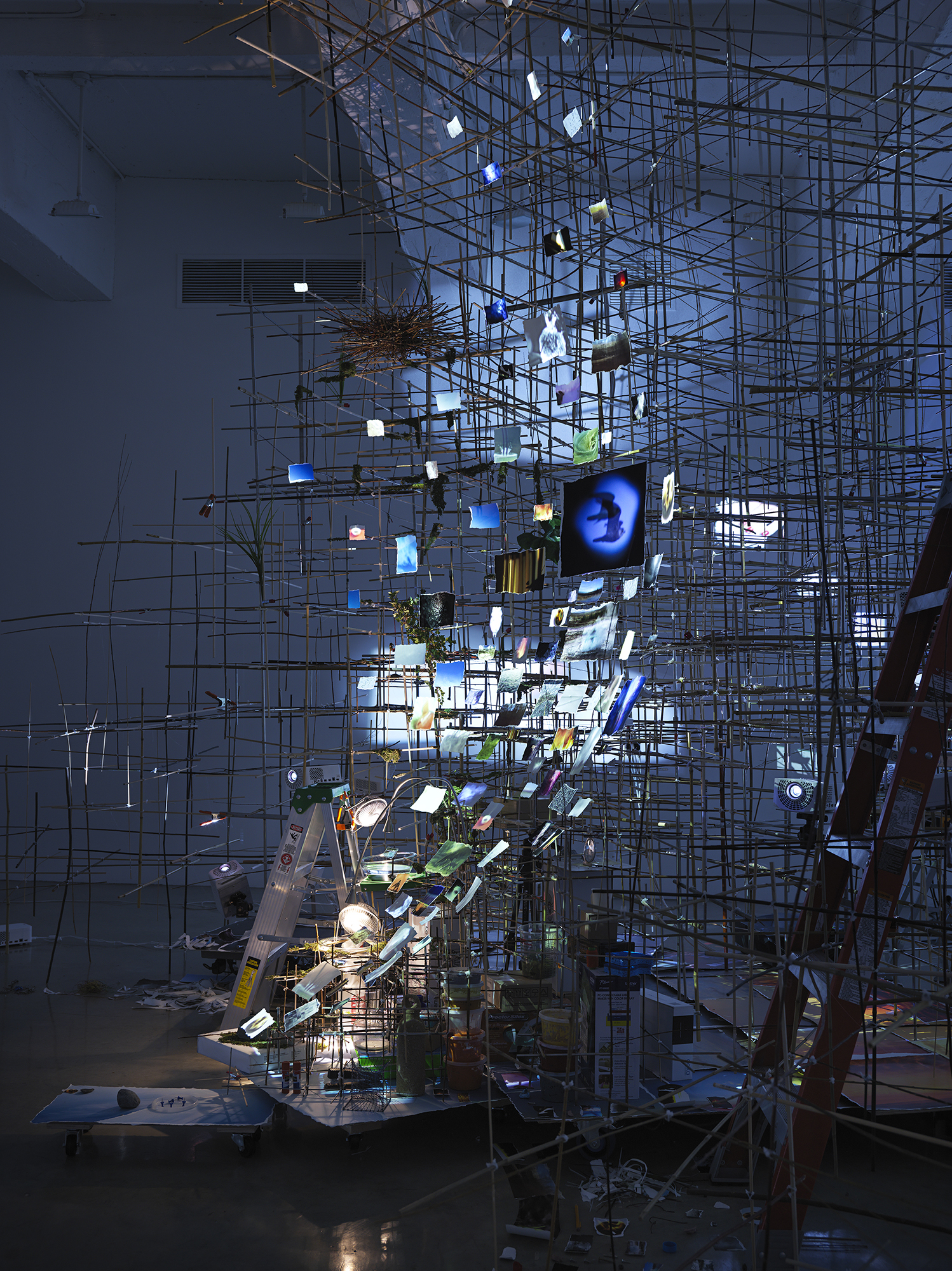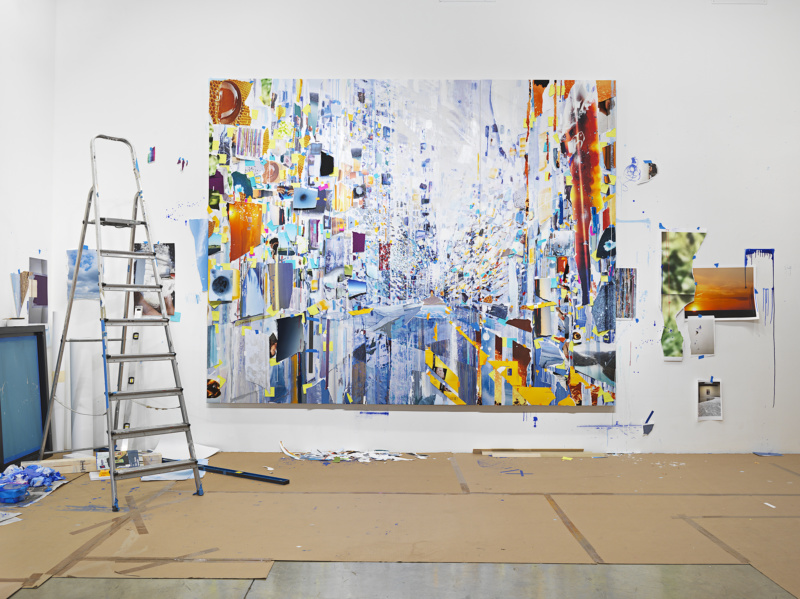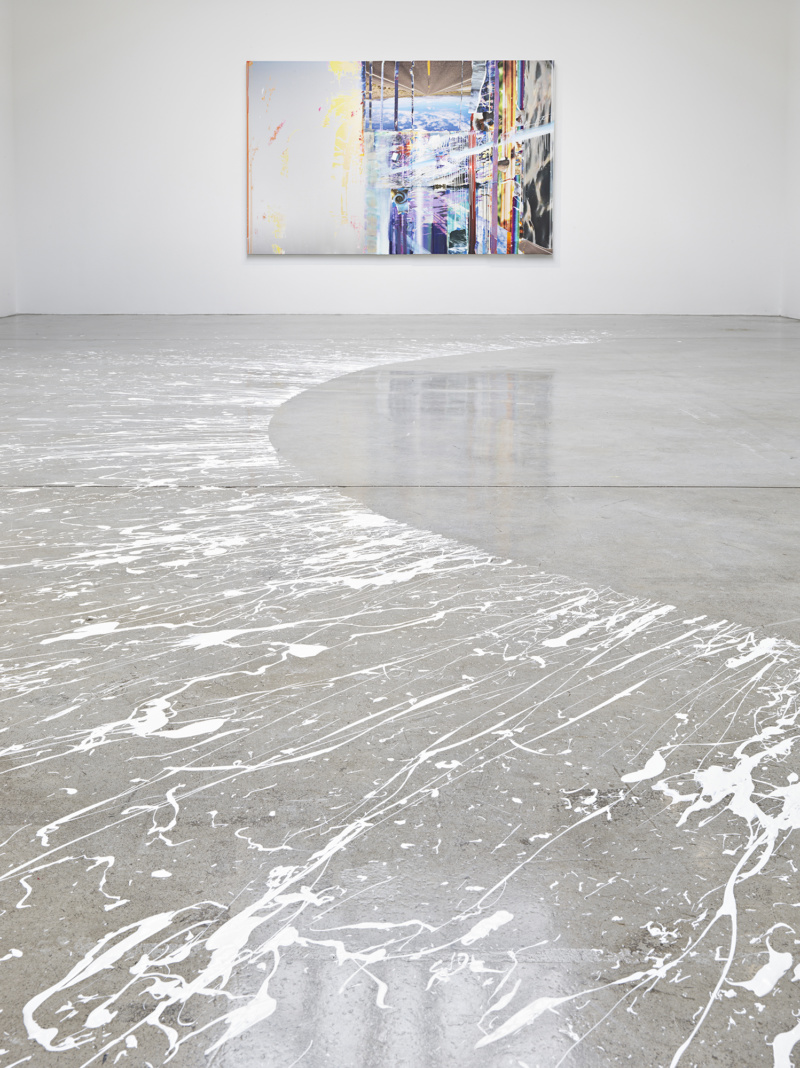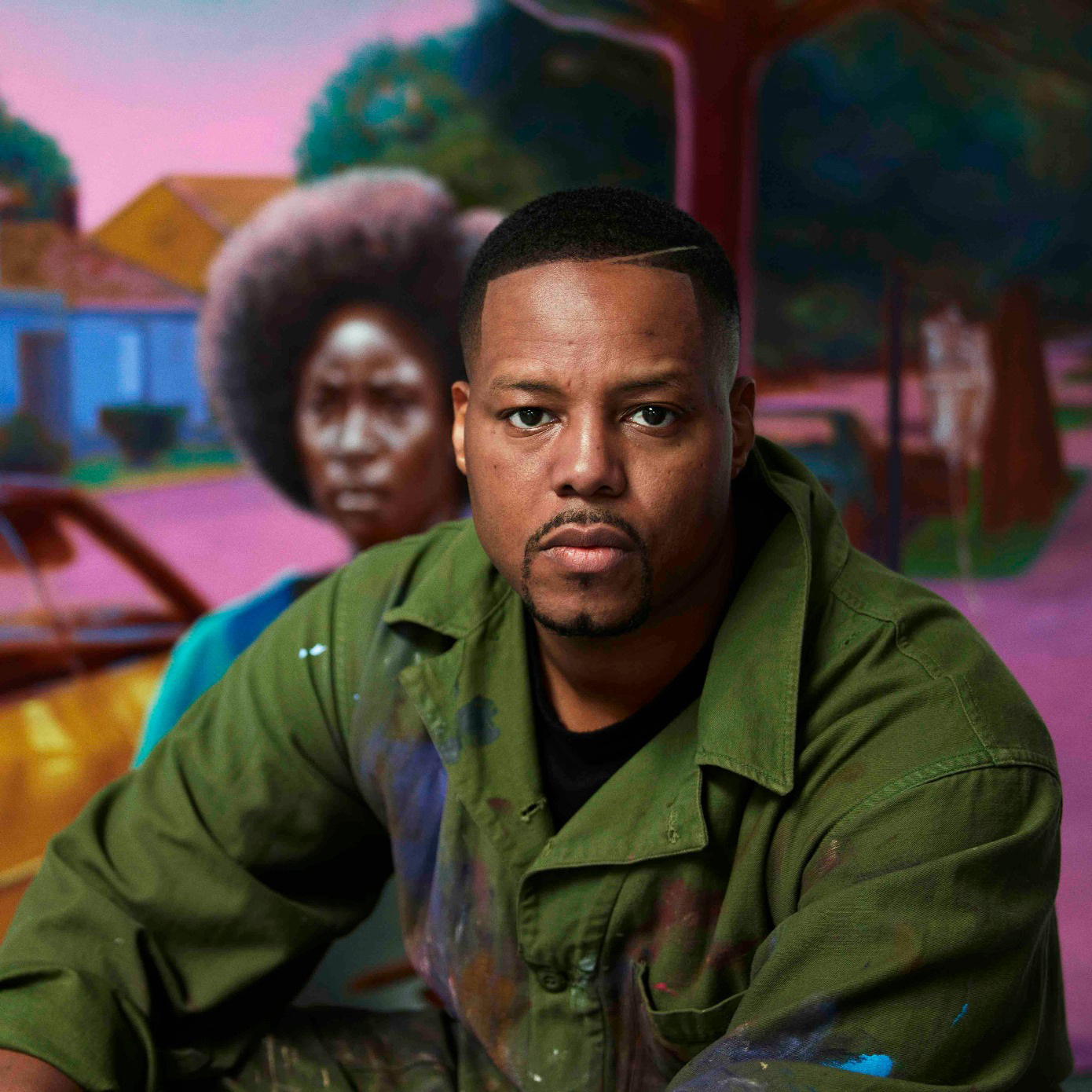
To the uninitiated, Sarah Sze’s art can feel like a vortex of wire, string, splattered paint, color photos, rocks, plants, and detritus, or, in the case of her most recent New York show, Poland Spring bottles and a prism of Toblerone chocolate. Critics place her among the likes of Marcel Duchamp and Jason Rhoades, a modern-day readymade artist whose sculptures call to mind an explosion in a hoarder’s basement. Yet Sze, a 2003 MacArthur fellow and Columbia University Visual Arts professor who represented the United States at the 2013 Venice Biennale, is anything but haphazard. Far from a random blast of materials and spliced content, her sculptural worlds and collaged paintings in fact reveal one of the most systematic, precision-driven minds of twenty-first century art and her latest body of work transforms the boundary between gallery and studio, construction and completion.
Sze’s newest exhibition (which opened at Tanya Bonakdar in Chelsea last week and is on view through late October) unfolds over two floors, uniting a complex constellation of objects and images that afford the viewer a rare opportunity to glean the inner workings of Sze’s creative process and trace the usually opaque journey from actually making the work to mounting a white-walled exhibition. There’s a magical quality to the show’s centerpiece Crescent (Timekeeper) (2019), in which moving images are projected onto small pieces of shredded paper and suspended from a curved tower of scaffolding.
In a black jumpsuit and white sneakers, Sze arrived at the gallery on a Friday evening after close to discuss the inverse relationship between the upstairs and downstairs portions of her exhibit. She wanted to create a show that toggles between pieces in their final form and the raw, intimate spaces where an artist actually works. Images in Translation (2019) is a studio space for video production, a precursor to the monumental, flickering lights of Crescent (Timekeeper), the realized video sculpture below. Behind that, visitors experience a painting studio, After Studio (2019), while the artist’s finished works hang on the floor above.

Your installations are often called immersive. But, this time you’ve used the outside of the gallery and papered the windows and doors with images. You utilize almost every surface. I wanted to use the entry of the building to start the conversation. I’m interested in public art and people who may never realize it is art. How many people actually see the outside of a gallery and break the boundary between public and private space? If you’re walking through Chelsea, you don’t necessarily know whether this threshold is an artwork or not. But when you turn the door knob and there’s paint on it, you’re already engaging in that question.
The items that look stored under the stairs, the heap of shredded paper on the front desk, the images scrolling across the wall—do these details create the feeling of crawling into your head? You have a finished sculpture down here [Crescent/Timekeeper], and then you come to the back of the first floor and you’re in an intimate, taboo space [Artist Studio]. For example, there’s a photograph of the place where the painting on this wall was made. There are all these layers of evidence, layers of what an installation is and what it means to be immersive.
This exhibition lets you go backstage. I am showing how these works came to be. If you go upstairs and spend time with the sculpture [Images in Translation], it will show you the process from the time the images are actually sculpted in the computer to when they come out of the projector, and even how they bleed into the walls and then the wall actually becomes the final translation. A lot of this show is built up over time.

So there’s a particular vulnerability or intimacy in this exhibition? I was definitely thinking, let’s just put it out there in a very “show the cards” way. Let’s show how the videos are made. I’ve exhibited many videos in Europe and everyone’s always asking, how do you get so many images? We are so accustomed to galleries where there’s a video and you either sit on a bench or on a rug on the floor. For this show, I was asking myself how can we make a sculpture that’s also a video? How can a video be a sculpture? How do you make a sculpture that records time or a video that feels like it has the texture of a painting or sculpture? The intimacy may also come from the idea that images are very much about memory. There’s always this moment where you recognize something and you have a sense of memory around it. You see all of these images, and though they’re not yours, there’s still this feeling that you know them.
When you stand before Crescent (Timekeeper), there’s a dreamscape quality to me. I feel suspended, half-asleep, half-awake, inside a subconscious. A curator who is now a director brought up Terrence Malick films. This sculpture has that kind of tone. I have done other pieces in the “Timekeeper” series, but this one actually pauses and goes silent, and then all these birds fly up in video projected onto the wall. And there’s a noise that you couldn’t hear at the opening. The sound is actually the buzzing that’s recorded during the making of the piece. The inspiration comes from Carl Sagan’s Sounds of the Earth. He constructed a time capsule of sorts called The Golden Record that contained all these weird images and natural sounds that were supposed to portray life on earth in such a way that it might be interpreted by a life form from another planet. That’s always been the basis of my decisions when making a show: how do you heighten the experience of being alive?
What about the recurring fox imagery in the show? There are these things I want people to latch onto, almost like mascots for the show. The bird is also iconic. There’s a fox running across the road in a crappy video. In a flash, it’s gone, like a sudden misstep that makes you perhaps just a little more alert. I want the viewer to be thrown off balance.
You’re known for weaving your creative process into the installation of the show in a heightened, site-specific way. I was working here in the gallery for about three weeks. It took me a long time to get the videos exactly right in the space. It’s quite laborious. For After Studio, everything in this space was decided in that time span. I went through tons of stages. There was a different painting here, a different painting there. The truth is, everything was made up: the rawness of it, the use of the ladders and the cardboard—which I really like because you don’t realize how operative it is. It changes your way of walking. People are supposed to walk on it.
I wanted to figure out how to make it a live studio. But it actually was a live studio because we had to figure out the environment in real time. We didn’t have any space so we put everything—rulers, painter’s tape, drills, projector boxes, rolls of printer paper—under the stairs, which is also a reference to Peter Fischli and David Weiss’s Room Under the Staircase (1993).
What is the relevance of the particular images you’ve sculpted for video? In “How-to” videos or ASMR videos on YouTube, you’re seeing materials in transformation, which can be very mesmeric and addictive. Witnessing honey drip or an ice cube melt is about time and transformation. I think that everything that’s outside of our eyes is material and everything that’s inside our heads is not. When we talk about the digital world, even that is a material thing. There’s also this idea of skipping back and forth between the mundane and the profound. You have a geyser or a sunset next to something very stupid like cutting soap—these are shifts in scale.
How would you explain the connection between the finished works and the studio spaces? One of the things I was thinking about is that I’ve generally been known as a sculptor. But I also have these almost secret studio practices and I was going to keep them behind doors and hide them. This show is really about pulling the dust out into the open and at the same time show how, as an artist, you create an interior space that allows you to exist more in your head.




